The Italian region of Liguria is famous for its dramatic landscape of mountains plunging into crystal clear waters, and narrow terraced fields leading down to tiny, colorful villages precipitously perched on the edges of cliffs of which the Cinque Terre (five lands) of Monterosso al Mare, Vernazza, Corniglia, Manarola, and Riomaggiore in La Spezia province are the most famous. It’s a region of hot, dry summers and cool, wet winters, though the rugged terrain creates many tiny sub-regional micro-climates, and driving through it, you can go from dry scrub oak and wild thyme to olive groves to chestnut forests and back again in half an hours’ journey.
So it is that Ligurian food, like all Italian regional cuisine, reflects the landscape from which it comes, and because of this much of the local food has traditionally come from the few plants that are able to withstand the poor, dry soil, the salty air at low altitudes, and the cold at higher elevations, supplemented by seafood and, occasionally, game and poultry.
**Sorry for interrupting your reading, but I had to find a place to put this picture in. No lie, we passed this goat going about 45 mph in the Ligurian countryside and I thought I was hallucinating. I made Jonny reverse about 1/4 of a mile down a very winding, thin road to find out if I really was on drugs. This Gandolf-looking creature was smiling from behind a very primitive and small barn about 5 inches off the side of the road. I fell in love at that moment. He looked mythical!
In her recent paean to the Liguria of her ancestors, The Lost Ravioli Recipes of Hoboken, author Laura Schenone recalls that while things have changed in modern times, for millenia the fortunes of most of the region’s inhabitants have been directly related to the availability of chestnuts from which many staples were made — including the ubiquitous gnocchi and pasta.
Another plant that grows very successfully in Liguria’s poor soils, as they do a few hundred miles west in the rocky garrigues of Provence where they remain the 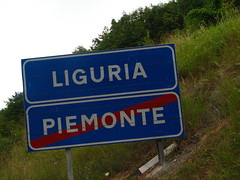 principle diet of many peasant farmers and, indeed, their livestock, is the chick pea (ceci/garbanzo), and like the chestnut, Ligurians pound the dried cecis into a flour which they use to make a kind of flat bread found nowhere else in Italy save certain parts of Sicily (which is deep fried chickpea dough often used in between bread or as a snack called Panelle – we hope to make this version soon), farinata. The French have their own version of this called Socca, but today we will focus on farinata. Farinata is a kind of street food found in Liguria and can often be treated like pizza as it is often cut into wedges and can come with various toppings like onions.
principle diet of many peasant farmers and, indeed, their livestock, is the chick pea (ceci/garbanzo), and like the chestnut, Ligurians pound the dried cecis into a flour which they use to make a kind of flat bread found nowhere else in Italy save certain parts of Sicily (which is deep fried chickpea dough often used in between bread or as a snack called Panelle – we hope to make this version soon), farinata. The French have their own version of this called Socca, but today we will focus on farinata. Farinata is a kind of street food found in Liguria and can often be treated like pizza as it is often cut into wedges and can come with various toppings like onions.
While we were in Genoa last summer, we saw farinata in bakeries all over 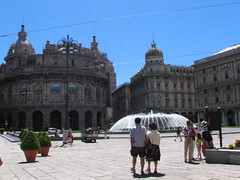 the city but, curiously, found that it wasn’t offered in restaurants, though it was probably because of the glut of delicious seafood and various pesto preparations we gorged ourselves on rather than this reason, that we missed out on trying farinata in the region of its origin. Not to be denied though, we sought out some chick pea flour (yes, I know, if weren’t such post-modern bourgeois slacker-tourists we would have pounded our own from dried beans…) at a wonderful gourmet grocers in Park Slope and proceeded to use the wonderful invention that is Babelfish to translate any number of recipes on Italian websites to find out how to make it authentically. If you can not find chickpea flour in your local grocery store, check out some health food shops, Indian and/or Middle Eastern specialty stores. Chickpea flour is a key ingredient to many Indian and Middle Eastern foods.
the city but, curiously, found that it wasn’t offered in restaurants, though it was probably because of the glut of delicious seafood and various pesto preparations we gorged ourselves on rather than this reason, that we missed out on trying farinata in the region of its origin. Not to be denied though, we sought out some chick pea flour (yes, I know, if weren’t such post-modern bourgeois slacker-tourists we would have pounded our own from dried beans…) at a wonderful gourmet grocers in Park Slope and proceeded to use the wonderful invention that is Babelfish to translate any number of recipes on Italian websites to find out how to make it authentically. If you can not find chickpea flour in your local grocery store, check out some health food shops, Indian and/or Middle Eastern specialty stores. Chickpea flour is a key ingredient to many Indian and Middle Eastern foods.
Regular readers will know that we strive to find and make the most authentic preparations we can, but you will also know that this kind of research often leads to the unfortunate conclusion that there is rarely only one “authentic” version. Referring again to Laura Schenone, who describes farinata as almost like a chick pea flour focaccia – crispy on top and soft and chewy underneath and baked in a wide, shallow pan in a brick pizza oven, we found that this conflicted with our recollections and other recipes we had come across for thinner, almost completely crispy flatbreads. In fact, what we discovered was that the longer the cooking time and the less batter you add to your skillet, the crisper the farinata. Like, duh, right? For a more baked polenta-like consistency underneath with a crisp top, I would recommend pouring enough batter so that it is 1/2-deep and cooking our recipe for 1/2 the time, possibly finishing it off under the broiler for a few minutes. The recipe below will be for a crispy version of farinata – one that almost can crack like a cracker.
**Window shopping in Genoa – check out the farinata being served in the upper right-hand corner
We would like to try the softer version so we can decide which we prefer. Regardless, we thoroughly enjoyed the crispy, thinner and darker bread with its nutty, salty flavor that we made and are enthused to attempt the latter as soon as possible.
Typically, farinata is eaten either alone or dipped in good Ligurian olive oil and sprinkled with sea salt, whereas we decided to use it almost as a canvas for a rather overly decorative carpaccio of zucchini (courgette) with pine nuts, shaved pecorino, and lemon juice. We encourage you to make yourself a farinata or two (preferably not in the hot months as we did, unless you have a good AC!) and eat it anyway you like, reminding yourself, yet again, that peasant food made from humble ingredients is almost always good, and because that’s often all there was/is to eat, it has to be.
CRISPY FARINATA (LIGURIAN CHICKPEA FLATBREAD) WITH ZUCCHINI CARPACCIO SALAD – (makes about 1 12-inch farinata)
Ingredients for farinata:
- 1 1/4 cup of chick pea flour
- 1 1/2 cups of water (maybe a bit more to get the consistency somewhere between whole milk and lite cream)
- 1 teaspoon kosher or sea salt
- 1/4 cup extra virgin olive oil (or enough to cover your pan)
- plenty of freshly ground black pepper
- 6 sage leaves, thinly sliced
- 1 teaspoon of chopped rosemary (optional)
Ingredients for zucchini salad:
- 1 large zucchini, sliced into paper-thin slices using a mandoline
- 1 ripe roma tomato, sliced into small dice
- 2 tablespoons pignoli nuts (pine nuts)
- 1 scallion (spring onion), sliced into thin rings
- 3 tablespoons good extra virgin olive oil
- 1 teaspoon whole grain mustard
- 1 salted anchovy filet
- 1 tablespoon fresh lemon juice
- pinch of salt and black pepper
What to do:
- Sift your chickpea flour in a bowl and add your salt, pepper, sage and rosemary. Stir generously.
- Slowly add your water, whisking the whole time allowing everything to be incorporated (again, you want the batter to be about the consistency of whole milk/light cream).
- Allow your batter to rest for at least 1 hour or as long as overnight.
- When you are ready to cook, preheat your oven to 425 degrees. If any foam has surfaced on your chickpea batter, remove with a spoon.
- Pour olive oil into your 12-inch baking pan – preferably a cast iron skillet. You want the olive oil to generously coat the bottom and sides of your skillet. Add your batter until it is about 1/4 of an inch if you want it super crispy or 1/2 inch deep if you want it thicker and possibly softer.
- For a crispier farinata, bake for about 30 minutes. Check on it, though, as ovens differ and you do not want the batter to burn! If you want it a bit softer, I would recommend baking for about 15-17 minutes and then finishing it under the broiler for a minute. Allow to cool before cutting!
- Slice zucchini into very thin, long slivers using a mandolin or a very sharp chef’s knife and thinly slice/dice your other veggies. Arrange everything on top of your farinata and sprinkle with pine nuts.
- Using a mortar and pestle, pound the anchovy and the mustard together and squeeze in the lemon juice and then mix well. Immediately before serving, whisk in the olive oil to make the vinaigrette. Season with salt and pepper and drizzle all over the zucchini carpaccio and farinata.
Check out some other posts you may enjoy:
- BEET AND RICOTTA FILLED RAVIOLI WITH BROWN BUTTER AND POPPY SEEDS
- ITALIAN-STYLE SLOW ROASTED PORK SHOULDER WITH SALSA VERDE
- FUSILLI WITH SALSA DI NOCI AND MUSHROOMS (WALNUT PESTO)
- European Roast…? (Why Coffee Tastes Better There)
- Drink of the Month: Vin Santo (May, 2008)
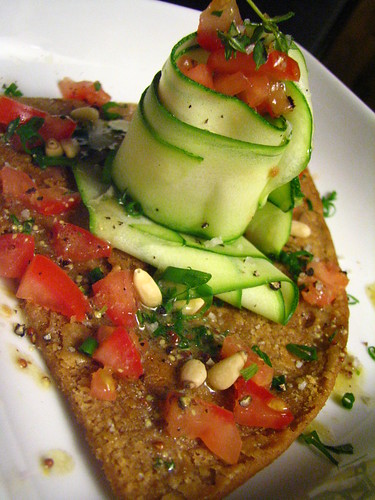
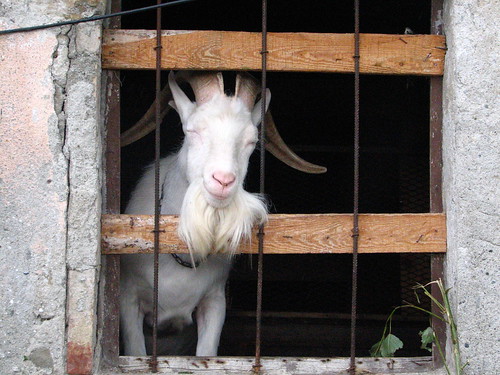
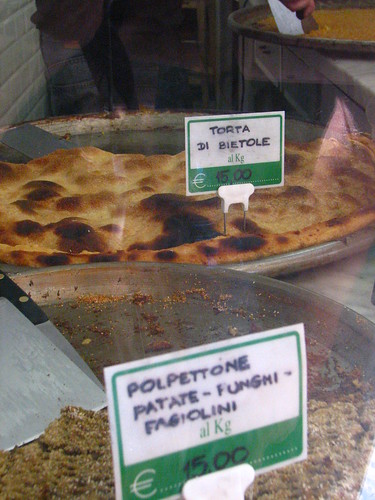
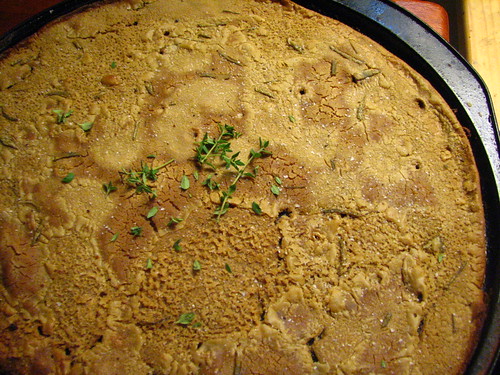
Nice article..and I love that smiling goat! 🙂
I agree with Maryann. Who couldn’t love that face? :-p
Very interesting post. I’ve never cooked with chickpea flour before, and I’ve never come across farinata in my Italian travels. It looks great!
That goat is awesome. He just got high off some wheatgrass or something 🙂 Chickpea flour? Very cool. I’m thinking anything can be ground into flour… why not?
It’s Grandpa Goat!
Thank you for all that information about Liguria and farinata. I’ve always wanted to visit there and maybe someday. In the meantime, I should get me some farinata ’cause it looks yummy.
That looks good! Nice presentation with the zucchini roll on top.
unbelievable…
i was just going through a lidia bastianich book and bookmarked panelle. i even bought the garbanzo flour last week. i’m making it with grilled tuna as she suggests – and soon.
your recipe and results are absolutely wonderful…
Love the goat. I am so glad you stopped –his face is too sweet. Like a wise old soul.
Just picked up some Chickpea flour at WHole Foods per Hank Shaw’s recommendation–must be in the air.
Amy,
I’ll tell you what’s cool. That we live in an age where people like you and your husband (assuming he has that status) can travel and share food stories from different countries for all to see. My wife and I are similar to you two. We travel extensively, and go out of our way for good food. I’ve been to Italy several times and have never heard about Farinita. I love the fact that you are exposing this to us. Great post. Love the goat.
–Marc
Mmm. Good food and good tales. All the makings for a great blog. Am really enjoying the reading (and the education). Thanks!
Wow! That looks wonderful…I’ve got garbanzo flour in the pantry, too. Gluten Free goodness!!! That goat is just too cute…it really *does* look like he’s smiling!
Oh man, that goat looks like a deity! I love that photo so much. The flatbread’s not too shabby either.
All your posts are so intereresting. I learn a lot from them. This one is no exception. I have never worked with chickpea flour and I loved the idea a lot. That goat looks sooo funny – great shot:) I am still laughing:)
You know how there are some posts you write that you just like? This was one for me. I could stare at that goat picture for hours. i was happy to see that others got the same joy out of him as i did.
but back to the farinata – I’m so glad to hear that a few of you have purchased some and I really look forward to reading what you do w/ it (re: claudia).
chefectomy : i totally agree. it’s so awesome to be able to share these stories and pictures (and recipes!). Thanks for the comment!
Lo: Much appreciated! Please come back again!
Heather: DEITY! That’s the word I was trying to think of… right on.
Farida: we really appreciate that you learn things from the blog. we really do! it’s prob. the biggest compliment we can get. thanks so much.
i heart that goat… i really do.
THAT GOAT IS SO FREAKIN SCARYYY!!! good thing this blog is AWESOME!! I cant believe how amazing these comments are too! well deserved bc you two are wonderful writers, bloggers, cooks, and mates…love you! xoxo
Oh, there are so many fabulous things about this post. The zucchini is gorgeous! The flatbread is wonderful! And you absolutely nailed the description of the animal. He is a “Gandolf-looking creature!”
Looks great! I wonder if they have chickpea flour at Wholefoods?
I love reading you blog, but I have one complaint. No matter what time if day it is, or how full I am, I always have hunger pangs by the time I finish a post! Thanks for the interesting stories.
I sooooooo made this for guests last night – it was SO DELICIOUS! The leftover farinata was great with lunch today, too…. 😀
Very interesting post. I love to come here and learn about a food that I know nothing about. I also like the title “nutty canvas.”
So glad you interrupted the post to insert the smiling goat. He made me smile back at my computer.
It looks like it’s the goat that’s on drugs. Seems like he’s having way too good of a time.
I always get chickpea flour from the local Indian groceries. There are so many uses for it.
Thanks for the comment. It was a ray of sunshine on a cludy day type meal. Your pics are wonderful and I love Gandalf. He looks like he is smiling. My daughter and I are hoping to spend some time in Italy next summer so I am gathering all sorts of advice at the moment. Thank god for bloggers!
Kudos to your determination and passion in replicating such traditional cuisine in a domestic kitchen! It’s admirable!
Oh, what an adorable goat! My hubby is gonna be really glad seeing this photo! I so have to show it to him!
I love the ‘Gandolf looking creature’. Amazing! 🙂
We’re all into flatbreads these day, i just made a catalan coca. hehe.
Never had farinata before but it’s certainly on my list now. I love anything with chickpeas or chickpea flour in it. You said you bought the flour in Park Slope? In which food shop may i ask? I’m having a hard time finding it in my usual spots in Manhattan.
Wow, good for you for making your own farinata! I love having it when we go to Liguria to the beach, but I haven’t been pushed to make it myself yet! Thanks for visiting me, I love making new blog buddies and I look forward to coming back for more.
Thanks all! Yes, that goat DOES look like it’s just taken a big puff on the peace pipe if you know what i mean!
S Carrico: Thank you so much for trying this out- more than that – thank you for enjoying it!
Marc: the should have chickpea flour at whole foods. supposedly, you can also crush with a mortar and pestle uncooked chickpeas and get it. Haven’t tried that, though.
And zenchef: mmmmm… i have to check out your coca recipe. awesome. we bought ours at a really great neighborhood spot I love called “D’Vine Taste” at 150 7th ave. It’s been under new management for over a year now and it’s only gotten better. They have a whole area for spices and flour where you buy what you need and weigh it. This is the best part of it. it’s owned by middle-easterns I believe, but they have EVERY type of food/food products there. Give it a try! it’s worth the trip in.
I love that goat!
No matter how that tastes, I think you could win a prize for presentation. It looks just beautiful.
I love the picture of the goat! I live in suburbia so not that many farm animals but there is this man who walks his goat all the time and is too cute! The food looks so yummy, by the way.
I love that first photo! What a beautiful dish. I’d love to try that chickpea flatbread. And that goat is so very cute.
WOW!
I JUST ate the farinata I took out of the oven 10 minutes ago. YUMMY! My husband and I had our honeymoon in Italy a month ago. We spent some time in the Genoa area and ate lots of farinata. This recipe really brought us back there! For some added flavor, try putting fresh pesto on top of the batter before putting the pan in the over. Take a fork to spread it about. Delicious. Thank you for sharing this recipe. 🙂